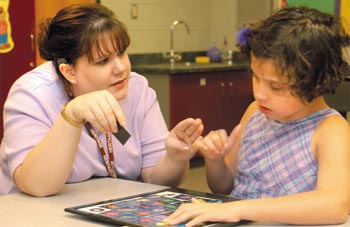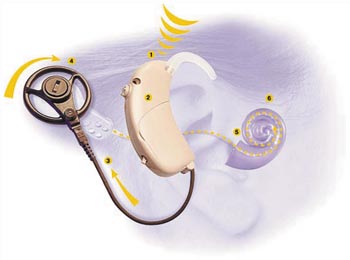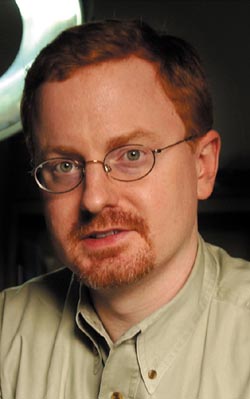
Meredith Atchison, a special education teacher at Heritage Elementary School in Williamson County, works a puzzle with student Dustye Moss. Atchison received dual cochlear implants at Vanderbilt earlier this summer and can now hear sounds that she never heard before, like the students’ voices. (photo by Dana Johnson)
Dual cochlear implant performed at Vanderbilt

How cochlear implants work: 1. Sound is received by the microphone. 2. The sound is analyzed and digitized into coded signals by an internal chip. 3. Coded signals are sent to the transmitter. 4. The transmitter sends the code across the skin to the receiver where it is converted to electronic signals. 5. Signals are sent to the electrode array in the cochlea to stimulate the hearing fibers. 6. Signals travel to the brain where they are recognized as sounds, producing a hearing sensation. (Courtesy Cochlear Corp.)

Dr. Robert Labadie
Doctors at Vanderbilt University Medical Center are the first in Tennessee to implant sophisticated hearing devices on both sides of a patient’s head.
The operation, performed last month in a 25-year-old Williamson County special education teacher, was performed as part of a national study to compare “bilateral cochlear implants” to devices implanted on only one side of the head.
Cochlear implants have been available for 20 years to restore hearing to people with profound hearing loss. An electrode carries signals from a small transmitter imbedded in the temporal bone right behind the ear into the coil of the cochlea, the shell-shaped structure in the inner ear that normally translates sound vibrations into electrical signals the brain can “hear.”
Most people have received implants in one ear. Increasingly, however, researchers are recognizing the value of restoring hearing in both ears.
“Hearing out of both ears is so important, because when you drop your keys or you hear a car coming down the road, you don’t know where the sound is coming from if you have only one functional ear,” said Dr. Robert Labadie, assistant professor of Otolaryngology. Labadie and Dr. David Hayes, associate professor of Otolaryngology and director of the cochlear implant program at Vanderbilt, performed the surgery on July 15.
“These patients do fantastic,” said Labadie. “It increases their word recognition … which means going to a noisy environment like a restaurant and being able to communicate … having virtually no limitations on their hearing.”
“It’s changed everything,” said the teacher, Meredith Atchison, who had experienced progressive hearing loss from the time she was a toddler. On Aug. 9, the device was turned on for the first time. “I went home and started hearing sounds I’d never heard before – crickets, birds, the weirdest things,” Atchison said.
Ironically, Atchison said she had just found out from an audiology test last spring that she had lost all of her hearing, when her mother, Brenda Atchison, saw a story in the Reporter on Vanderbilt’s cochlear implant program. The story was part of a five-part series on the Vanderbilt Bill Wilkerson Center for Otolaryngology and Communication Sciences.
“Your Vanderbilt Reporter actually got this whole cochlear implant ball rolling with us in the first place,” Brenda Atchison said.
Meredith Atchison, who works at Heritage Elementary School in Thompson Station, is the seventh patient in the United States to receive bilateral cochlear implants made by MED-EL (Medical Electronics) of Innsbruck, Austria.
Vanderbilt is one of five medical centers participating in the MED-EL study. Four patients at the University of North Carolina and two at the Medical College of Wisconsin also have received bilateral implants. In addition, about 20 patients at the University of Iowa in Iowa City have received bilateral implants made by the Cochlear Corporation.
There are some risks to the surgery, Labadie said. The facial nerve that runs through the inner and middle ear can be damaged during the surgery, resulting in facial paralysis, but that has happened in far less than 1 percent of the more than 40,000 cochlear implantations that have been performed worldwide and never at Vanderbilt, he said.
Recently there has been concern that the operation may increase the risk of meningitis, but the incidence of the brain infection in patients with cochlear implants approximates that in the general population, he added.
At $35,000 per ear, however, the procedure is expensive, and few insurance companies cover both ears. Labadie said he hoped the cost would come down as the technology improves.
For more information about bilateral cochlear implants, call the Bill Wilkerson Center at 936-5000.













